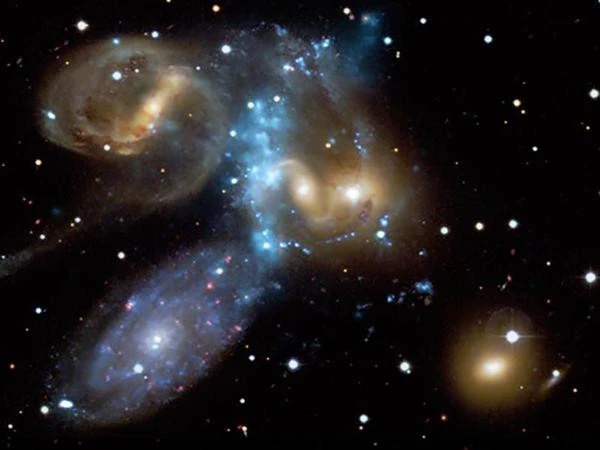
X-ray radiation, located between ultraviolet rays and gamma rays in the electromagnetic spectrum, has wavelengths between 0.01 and 10 nanometers. These highly energetic photons (on the order of \(10^2\) to \(10^5\) eV) easily pass through diffuse gases, making space in this domain practically transparent. X-ray sources are thus visible through regions otherwise opaque in the optical, revealing extreme astrophysical objects and phenomena: black hole accretion disks, supernovae, neutron stars, galaxy clusters.
X-rays do not penetrate the Earth's atmosphere, necessitating their detection via space telescopes such as Chandra, XMM-Newton, or NuSTAR. These instruments capture photons from plasmas at several million kelvins, such as those present in the shock waves of supernova expansions or in the relativistic jets emitted by active galactic nuclei. Galaxy clusters, trapped in halos of hot gas, also emit intensely in this domain, allowing the measurement of their gravitational masses via X-ray emission from intergalactic gas.
X-ray astronomy has transformed our understanding of dark matter, stellar evolution, and the formation of large structures. By revealing components of the universe invisible in the optical spectrum, it completes our image of the cosmos. X-rays trace extreme gravity, intense magnetic fields, extreme temperatures, and the quantum processes at play in deep space.
Black holes, though invisible by definition, reveal their presence through the X-ray emission from the accretion disks surrounding them. Matter spiraling toward the event horizon is compressed and heated to temperatures of several million kelvins, emitting very energetic X-ray photons. Rapid variations in X-ray flux allow probing the immediate vicinity of the black hole, down to a few Schwarzschild radii. Spectroscopic analysis of X-ray lines, distorted by gravitational effects, provides constraints on the mass and spin of the compact object.
Neutron stars, dense remnants of supernova explosions, generate magnetic fields that can reach \(10^{12}\,\mathrm{G}\). In the extreme cases of magnetars, this field exceeds \(10^{15}\,\mathrm{G}\), inducing intense X-ray emissions through quantum vacuum diffusion or rearrangement of the neutron crust. X-ray pulsars emit periodic radiation, detected by high temporal resolution X-ray instruments. These intense fields also modify the structure of atomic energy levels, observable in X-ray spectra through the quantum Zeeman effect.
Galaxy clusters contain immense volumes of intergalactic gas heated to temperatures on the order of \(10^7\) to \(10^8\,\mathrm{K}\). This plasma emits X-rays mainly via bremsstrahlung radiation and emission lines from ionized heavy elements (iron, silicon, sulfur). X-ray analysis allows mapping the density and temperature of this gas, providing an estimate of the total gravitational mass of the cluster, and consequently, the dark matter it contains. Thermal perturbations observed also reveal cluster mergers and cosmic shock waves.
X-ray astronomy probes quantum processes under conditions inaccessible on Earth. During supernova explosions, the shock front heats the medium to several million kelvins, and the synthesized nuclei (Fe, Co, Ni) emit in the X-ray domain. In the relativistic jets of active galactic nuclei (AGN), synchrotron or inverse Compton radiation produces non-thermal X-ray spectra. Finally, in low-collision plasmas, excitation and ionization rates strongly depend on non-equilibrium populations, accessible only via high-resolution X-ray diagnostics.
| X-Ray Source | Temperature (K) | Emission Mechanism | Spatial Scale | Duration/Variability |
|---|---|---|---|---|
| Stellar Black Hole | \(10^6 - 10^8\) | Accretion – Thermal Radiation | ~10–100 km | ms to days |
| Neutron Star / X-Ray Pulsar | \(10^6 - 10^7\) | Accretion / Synchrotron / Cyclotron | ~10 km | milliseconds to seconds |
| Magnetar | \(10^6 - 10^8\) | Crustal Rearrangement / Magnetic Field | ~10 km | Sudden outbursts (days to months) |
| Supernova / Remnant | \(10^6 - 10^8\) | Shock – Bremsstrahlung / Emission Lines | ~10–100 light-years | ~\(10^4\) years |
| Galaxy Clusters | \(10^7 - 10^8\) | Hot Plasma – Bremsstrahlung / Lines | ~Mpc | Stable over \(10^9\) years |
| Quasar / AGN | \(10^6 - 10^9\) | Accretion + Relativistic Jets (Inverse Compton) | ~0.01–10 pc | Hours to centuries |
Sources: NASA HEASARC (2023), Chandra X-ray Observatory Science Center (2024), Rybicki & Lightman – *Radiative Processes in Astrophysics* (Wiley, 2004).